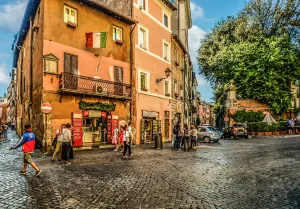In antiquity, it was first populated by the Etruscans, then by the Romans, some of whom even built imposing villas here. During the Middle Ages, Trastevere transformed into a working-class neighborhood, becoming one of the poorest in the city.
Today, it has a unique charm, known for its nightlife. With its narrow, cobblestone, winding streets, old colorful buildings, and locales with a typically Italian ambiance, picturesque Trastevere welcomes its visitors with an authentic Roman atmosphere.
In Trastevere, besides wandering the streets to enjoy the neighborhood vibe where the Italian "dolce far niente" is best felt, we did not want to miss the Basilica of Santa Maria and the Church of San Francesco a Ripa, each valuable in its own way.
Taking the path along the Tiber River, with the river on our left on Lungotevere Farnesina, we leave the Villa Farnesina on the right and stop at Piazza Trilussa in front of Ponte Sisto, a historic bridge from 1479.
From the entrance, we admire the Fontana di Ponte Sisto, located at the end of a flight of steps, and the small Trilussa monument, then we get lost in the twisting alleys where we encounter a plethora of osterias, trattorias, and pizzerias that were preparing to start their day.
We arrive at Piazza di Santa Maria, with the Fontana di Santa Maria at its center and the Basilica of Santa Maria in Trastevere on one side. This church is famed for being the first place of worship in the city dedicated to the Virgin Mary, built on the site where a spring of oil miraculously sprouted on the day Christ was born, a miracle depicted in the splendid mosaics in the apse.
The oldest church in Rome, dating from the time of Pope Callixtus (217-222 AD), though later expanded, with its current form finalized in the 12th century, the basilica is also renowned for its unmatched columns, but especially for the rare 7th-century painting, Madonna della Clemenza, which we found in the chapel to the left of the altar.
Not to be overlooked either is the ceiling, a work by Domenichino, rather to be admired. Of special beauty, this church proves to be untouched by the passage of years or by the baroque phenomenon.
After more strolls through narrow streets and a light snack standing up at a small neighborhood terrace, we head to the other site we had in mind, the Church of San Francesco a Ripa, located at the southern end of the neighborhood.
We made it a point to visit it because it houses one of the masterpieces of the brilliant Bernini: Beata Ludovica Albertoni, created by the artist between 1671-1674; otherwise, the Baroque building would not attract too much attention from the outside.
The sculpture dedicated to the noble lady who, after her husband's death, devoted her life to the poor, is superb, the character captured in a religious trance conveys an emotion hard to describe.


